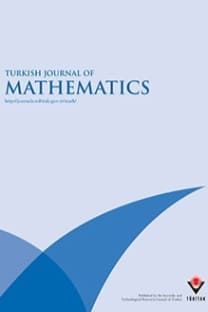Degenerate Hopf bifurcations, hidden attractors, and control in the extended Sprott E system with only one stable equilibrium
Chaotic attractor, stable equilibrium, Sil'nikov's theorem, degenerate Hopf bifurcations, hidden attractor
Degenerate Hopf bifurcations, hidden attractors, and control in the extended Sprott E system with only one stable equilibrium
Chaotic attractor, stable equilibrium, Sil'nikov's theorem, degenerate Hopf bifurcations, hidden attractor,
___
- Bao JH, Yang QG. Complex dynamics in the stretch-twist-fold flow. Nonlinear Dyn 2010; 61: 773–781.
- Chen DY, Shi L, Chen HT, Ma XY. Analysis and control of a hyperchaotic system with only one nonlinear term. Nonlinear Dyn 2012; 67: 1745–1752.
- Chen DY, Wu C, Liu CF, Ma XY, You YJ, Zhang RF. Synchronization and circuit simulation of a new double-wing chaos. Nonlinear Dyn. 2011; 10: 1–24.
- Chen GR, Ueta T. Yet another chaotic attractor. Internat J Bifur Chaos 1999; 9: 1465–1466.
- Dias FS, Mello LF, Zhang JG. Nonlinear analysis in a Lorenz-like system. Nonlinear Anal Real World Appl 2010; 11: 3491–3500.
- Hahn W. The Stability of Motion. New York, NY, USA: Springer-Verlag, 1967.
- Kuznetsov YA. Elements of Applied Bifurcation Theory. New York, NY, USA: Springer-Verlag, 2004.
- Leonov GA, Kuznetsov NV, Kuznetsova OA, Seledzhi SM, Vagaitsev VI. Hidden oscillations in dynamical systems. Trans Syst Contr 2011; 6: 54–67.
- Liu YJ, Yang QG, Pang GP. A hyperchaotic system from the Rabinovich system. J Comput Appl Math 2010; 234: 101–113.
- Lorenz EN. Deterministic non-periodic flow. J Atmos Sci 1963; 20: 130–141.
- L¨ u JH, Chen GR. A new chaotic attractor conined. Internat J Bifur Chaos 2002; 12: 659–661.
- Mello LF, Coelho SF. Degenerate Hopf bifurcations in the L¨ u system. Phys Lett A 2009; 373: 1116–1120. Mello LF, Messias M, Braga DC. Bifurcation analysis of a new Lorenz-like chaotic system. Chaos Solitons Fractals 2008; 37: 1244–1255.
- Pang SQ, Liu YJ. A new hyperchaotic system from the L¨ u system and its control. J Comput Appl Math 2011; 235: 2775–2789.
- Park JH, Lee SM, Kwon OM. Adaptive synchronization of Genesio-Tesi chaotic system via a novel feedback control. Phys Lett A 2007; 371: 263–270.
- R¨ ossler OE. An equation for continuious chaos. Phys Lett A 1976; 57: 397–398.
- Sil’nikov LP. A case of the existence of a countable number of periodic motions. Sov Math Docklady 1965; 6: 163–166.
- Sil’nikov LP. A contribution of the problem of the structure of an extended neighborhood of rough equilibrium state of saddle-focus type. Math USSR-Shornik 1970; 10: 91–102.
- Silva CP. Sil’nikov theorem-a tutorial. IEEE Trans Circuits Syst I 1993; 40: 657–682.
- Sotomayor J, Mello LF. Braga DC. Bifurcation analysis of the Watt governor system. Comp Appl Maths 2007; 26: 19–
- Sprott JC. Some simple chaotic flows. Phys Rev E 1994; 50: 647–650.
- Sprott JC. Simplest dissipative chaotic flow. Phys Lett A 1997; 228: 271–274.
- Sprott JC. A new class of chaotic circuit. Phys Lett A 2000; 266: 19–23.
- Van der Schrier G, Maas LRM. The diffusionless Lorenz equations: Sil’nikov bifurcations and reduction to an explicit map. Physica D 2000; 141: 19–36.
- Wang X, Chen GR. A chaotic system with only one stable equilibrium. Commun Nonlinear Sci Numer Simulat 2012; 17: 1264–1272.
- Wang X, Tian L, Yu L. Adaptive control and slow manifold analysis of a new chaotic system. Internat J Nonlinear Science 2006; 21: 43–49.
- Wang Z. Existence of attractor and control of a 3-D differential system. Nonlinear Dyn 2009; 60: 369–373. Wei ZC. Dynamical behaviors of a chaotic system with no equilibria, Phys Lett A 2011; 376: 248–253.
- Wei ZC, Yang QG. Controlling the diffusionless Lorenz equations with periodic parametric perturbation. Comput Math Appl 2009; 58: 1979–1987.
- Wei ZC, Yang QG. Dynamical analysis of a new autonomous 3-D chaotic system only with stable equilibria. Nonlinear Analysis RWA 2011; 12: 106–118.
- Wei ZC, Yang QG. Dynamical analysis of the generalized Sprott C system with only two stable equilibria. Nonlinear Dyn 2012; 66: 543–554.
- Yang QG, Chen GR. A chaotic system with one saddle and two stable node-foci. Internat J Bifur Chaos 2008; 18: 1393–1414.
- Yang QG, Wei ZC, Chen GR. An unusual 3-D autonomous quadratic chaotic system with two stable node-foci. Internat J Bifur Chaos 2010; 20: 1061–1083.
- Zhou TS, Chen GR. Classification of chaos in 3-D autonomous quadratic systems-I: basic framework and methods. Internat J Bifur Chaos 2006; 16: 2459–2479.
- ISSN: 1300-0098
- Yayın Aralığı: Yılda 6 Sayı
- Yayıncı: TÜBİTAK
Continuity of Wigner-type operators on Lorentz spaces and Lorentz mixed normed modulation spaces
Some rings for which the cosingular submodule of every module is a direct summand
Derya TÜTÜNCÜ KESKIN, Rachid TRIBAK, Nil ERTAS ORHAN, Patrick SMITH F.
On the size of the third homotopy group of the suspension of an Eilenberg MacLane space
Peyman NIROOMAND, Francesco RUSSO G.
Almost contact metric submersions and symplectic manifolds
Augustin BATUBENGE, Tshikunguila TSHIKUNA-MATAMBA
On Joachimsthal's theorems in Riemann--Otsuki space R-O3
Münevver Yildirim YILMAZ, Mehmet BEKTAŞ
Half-lightlike submanifolds with planar normal sections in R24
Feyza Esra ERDOĞAN, Rıfat GÜNEŞ, Bayram ŞAHİN
On semiparallel anti-invariant submanifolds of generalized Sasakian space forms
Cihan ÖZGÜR, Fatma GÜRLER, Cengizhan MURATHAN
A note on closed G2 -structures and 3-manifolds
Hyunjoo CHO, Sema SALUR, Albert TODD
